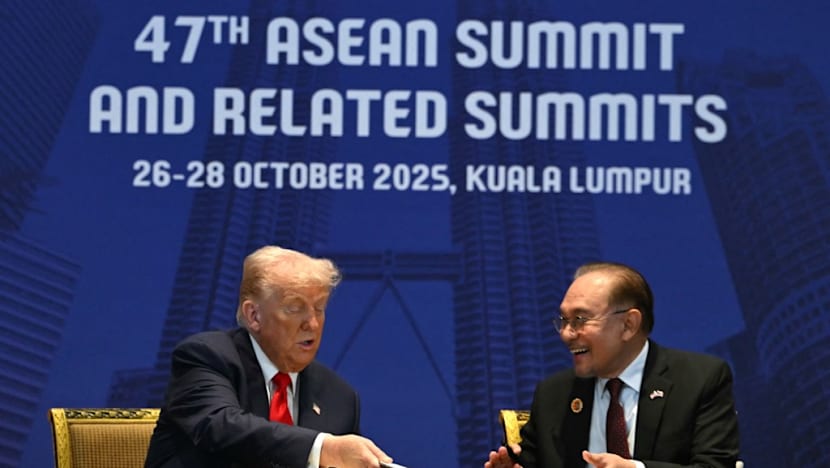Commentary: ASEAN knows what Trump wants, but did it give away too much?
The Association of Southeast Asian Nations' informal, personality-driven approach has proven valuable in times of global flux, says political analyst James Chai.

US President Donald Trump (left) and Malaysia's Prime Minister Anwar Ibrahim exchange documents during a bilateral meeting on the sidelines of the 47th Association of Southeast Asian Nations (ASEAN) Summit in Kuala Lumpur on Oct 26, 2025. (Photo: Andrew Caballero-Reynolds / AFP

This audio is generated by an AI tool.
KUALA LUMPUR: “You are spectacular leaders … Everything you touch turns to gold,” said United States President Donald Trump to Southeast Asian leaders, in his final remarks at the 47th ASEAN Summit in Kuala Lumpur on Sunday (Oct 26). Mr Trump’s tendency to reach for binary superlatives notwithstanding, it showed that he enjoyed the first Asian stop in his second term.
The “ASEAN Way” was on full display: Leaders embraced each other like long-lost friends; there was song and dance, even a birthday celebration, with smiles and jokes around. For a moment, we might forget that we are living in a world of geopolitical and trade tensions.
If the ASEAN Way was the Association of Southeast Asian Nations’ guiding rhythm, then this year’s rotating chair Malaysian Prime Minister Anwar Ibrahim was the conductor. Mr Anwar was a force of his own, with enough charisma - built through a 43-year dramatic political life - to afford a risky joke with a volatile leader and not land in trouble. “I was in prison, but you almost got there,” he joked on the things he had in common with Mr Trump.
Mr Anwar’s informal and personality-driven approach is an embodiment of how ASEAN has operated since its inception. It relies less on the formal structures, which holds neither economic nor military binding authority on member states, and often settles matters in an ad-hoc, face-saving, consensus manner.
The bloc has been criticised as a “toothless tiger”. But such an approach has proven valuable in times of global flux, fuelled by war of words, tariffs and guns, as ASEAN became the “dealmaking” stage for the world.
NON-CONFRONTATIONAL NEUTRALITY CAN PAY OFF
As Mr Anwar put it: “The day before we were with President Donald Trump … and today we are back with China. That reflects ASEAN’s centrality.”
Indeed, day one’s agenda included signing trade deals with the US (including elevating US-Malaysia trade relations to its highest level), and day two’s highlight was an upgraded trade deal between ASEAN and China (ACFTA 3.0).
By any measure, these deals separately would be significant. Having them signed consecutively was a masterclass of how non-confrontational neutrality could pay off.
The US-China negotiation framework was struck at the Merdeka 118 towers. Leaders of countries like Brazil, South Africa and Canada attended the summit amid spats with the Trump administration.
This summit boasted the largest and highest-profile roster in recent years. Leaders from almost every region attended; even the FIFA president was there. It covered nearly 60 per cent of the global population and gross domestic product, proving that ASEAN has been on many leaders’ minds.
SYMBOLIC PEACE KEEPS DIPLOMACY ALIVE
The second, related feature is ASEAN’s preference for symbolic peace.
On good days, like when a great power came by with subtle threats of economic coercion, a fragile ceasefire could become a high-signature diplomatic deal signed between warring countries.
There has been an uneasy calm at the Thai-Cambodian border since the first ceasefire deal in July, with repeated claims of alleged violations, psychological intimidation in the form of "wailing sounds" and the use of white phosphorus shells. Symbolic peace is important to ensure that risk of escalation is diffused quickly, so that any diplomacy could be kept alive.
Even though the deal was called the "Kuala Lumpur Peace Accord", the Thai foreign affairs minister was quick to describe it more as a "pathway to peace" instead. Still, it would be embarrassing for Thailand or Cambodia to have the deal break down so quickly after Mr Trump oversaw its signing. The ASEAN Way at least patched something together that was, on paper, still a win for those involved.
DEFERENCE WITHOUT SUBJUGATION
At the signing ceremony, the third feature of the ASEAN Way was also on display: deference without subjugation. It was reported that Mr Trump’s primary reason for stopping by Kuala Lumpur was to cement his role as a peacemaker who allegedly ended eight wars.
The challenges for ASEAN were: Whether Mr Trump would claim sole credit at the expense of Malaysia; whether Cambodia and Thailand would appear to have great power interference in its affairs; and whether ASEAN is seen as subjugated to Mr Trump by giving him the spotlight.
In the end, what Mr Trump got was a seat, the American flag backdrop, a speech, his signature, and photo-ops with the leaders in question.
While the ASEAN countries were complimentary to Mr Trump, they did not bend over backwards, nor did they let it seem like the US called the shots and they merely followed. (Except for the part where the Cambodian leader nominated Mr Trump for the Nobel Peace Prize, but this could be interpreted as a low-cost, high-yield tactical move, knowing how much Mr Trump cares about getting the prize).
They acknowledged the US’ contributory role, and Mr Trump did not claim credit at the expense of Mr Anwar. All parties won.
AN ASEAN SET OF PROBLEMS TOO
However, the ASEAN Way also comes with its problems that only simmer beneath the surface at a mega conference like this. The informal, personality-driven approach works well when personalities are strong and aligned, but it does not build on the collective regional strength of the institution.
Even though Malaysia was able to clinch a trade deal with the US, many others are still negotiating, and the outcomes may vary widely. The ASEAN-US meeting may have helped soften the region’s image in Mr Trump’s eyes, but deals are negotiated on a bilateral basis even though the tariffs affected every country comprehensively. Institutional strengths were not used to build bargaining power.
The preference for symbolic peace also hides many fundamental unresolved issues. While the Thailand-Cambodia peace accord has concrete provisions to de-escalate immediate tensions, it is questionable if the region has much influence in resolving a century-old border dispute. It is not even clear whether ASEAN desires to do so and to build capabilities to this end.
Lastly, deference without subjugation works on good days, but ASEAN’s role of balancing the two great powers will be increasingly challenging.
The US wants its signing parties to take its side. It made this explicit in the trade deal signed with Malaysia: It wants partners to take similar actions if it imposes trade measures (tariffs, quotes, prohibitions), crack down on transshipments and "origin washing", and avoid actions that harm the US (seen in Articles 4, 5.1, 5.2, 5.3).
While Malaysian Investment, Trade and Industry Minister Tengku Zafrul Abdul Aziz has defended the deal amid criticism that it compromised economic sovereignty, the space to hedge against both US and China will continue to shrink. This is not the same as simply increasing trade or signing free-trade deals with both countries. This is a legal document that contains potentially-constraining trade restrictions.
The true test, of course, lies when there are alleged violations.
When that happens, Malaysia, and ASEAN, would need to use everything in its ASEAN Way toolkit to manage the fallout and stay in the middle.
James Chai is a political analyst, columnist and the author of Sang Kancil (Penguin Random House).


















